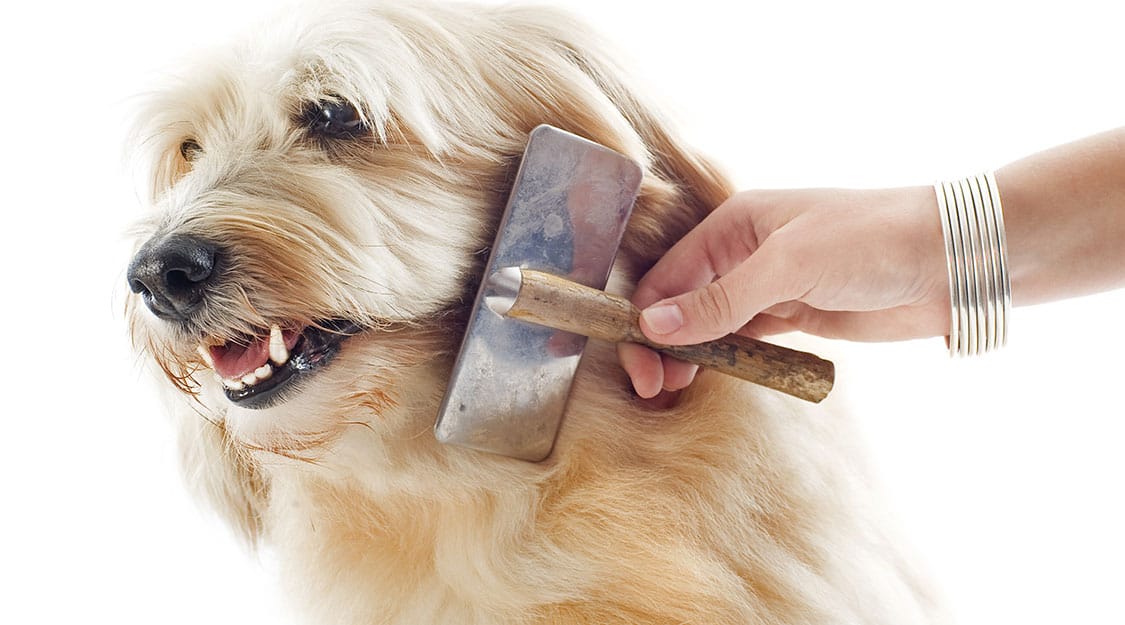With more than four hundred recognized dog breeds around the world and with so many breed mixes, we can find lots of different hair type combinations, with different grooming requirements for each hair type.
We can start by dividing them into three big categories:
- Straight Hair
- Curly Hair
- Wiry Hair
Within these three big groups, we can find three different lengths:
- Short
- Medium
- Long
And most of them can be divided into two subcategories:
- Double Coated (dogs with undercoat)
- Single Coated
To all this, we can still add more divisions based on how low or high maintenance the grooming requirements will be.
Purebreds
The benefits of having a purebred dog is that we can have a more certain idea of how the dog’s coat will evolve. Over years and even centuries of responsible breeding, purebred dogs have been “engineered” to carry on certain characteristics that are now embedded in their genetic makeup.
Therefore, we can for the most part expect the kind of coat our dog will have, their temperament, and the kind of activity they will require to stay in shape. This also makes it easier for us to learn and prepare for what we are getting into when we welcome a specific breed into our home.
Mixed Breeds
When adopting a mixed-breed dog, there is no long established reservoir of information to give any indication of the kind of coat, grooming requirements, and temperament he will have. As they get older, most puppies will start changing their puppy coats on their backs, starting at the base of the tail and moving forward to the neck as they grow.
If it is a terrier mix, the coat will follow the terrier genetic trait; the coat on the back, near the tail, will be the first area that will grow in harsh and wavy. If the dog has a drop coat, as the puppy loses his puppy coat (which is usually fluffy and woolly), the adult coat will grow in straight and shiny.
High Maintenance
Let us start by acknowledging that every dog is high maintenance with regards to all the attention he will need to be properly taken care of, but the degree of maintenance will depend on the breed.
There is no doubt that a Weimaraner will have much fewer grooming requirements than an Old English Sheepdog or a Pekingese. Although the length of the coat is not the only factor that will determine the level of grooming attention they will need, it is a major one.
Some dogs with short or medium-length coats could shed a lot, making them very high maintenance. A long-haired dog that only sheds seasonally or that barely sheds at all will still require a good grooming routine but much less vacuuming around the house.
Low Maintenance
Obviously, dogs with very short hair with no undercoat, such as a Weimaraner, a Miniature Pinscher, or an Italian Greyhound, are very low maintenance when it comes to grooming because they barely shed or don’t shed at all, making it very easy to keep their coats clean and shiny.
If there is one downside to this, it is that because they don’t require much hands-on attention, often they get less nail and ear care, making it even more important to start handling their paws and ears at a very young age to get them used to being touched and handled.
A dog with a low-maintenance coat could very quickly turn into a high-maintenance dog if every time we want to check his ears and nails we need to assemble a small army of people to get near him with nail clippers or a cotton ball.
Grooming Frequency
We have a simple rule of thumb when it comes to how frequently one should groom a dog. When the dog is no longer huggable, it is time to give him a bath. The dog’s living environment will also help determine how often you have to bathe him.
A dog that lives in a New York City apartment will get dirty very quickly just by walking around the block, especially if it’s raining. A dog that lives in a house with a well-manicured lawn will keep himself clean much longer, and by rolling in the fresh grass, he will give himself a “spa” treatment that we pay lots of money for in the big city.
The pet industry has a wide variety of shampoos for frequent baths that will clean the dog without removing the coat’s natural oils. As a general rule, the more frequently you plan to bathe your dog, the milder the shampoo should be.
Whitening and clarifying shampoos are usually the strongest shampoos because they are designed to strip the buildup of products that you have already used on your dog, and they will allow the light to reflect more and give the coat a more “glowing” illusion or appearance. Puppy and hypoallergenic shampoos are usually the mildest.

